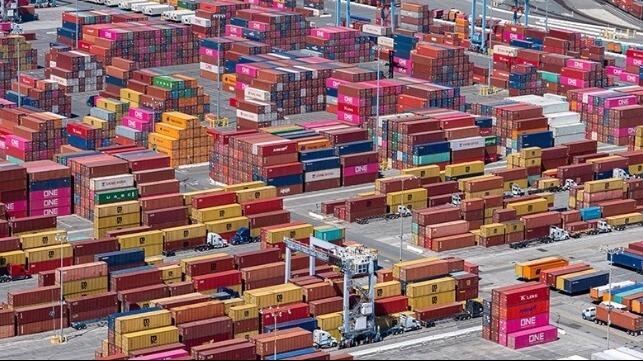PMA Study Highlights Port Automation Benefits Before Labor Talks

Ten days before labor negotiations are due to begin with the West Coast longshoremen’s union, their employers represented by the Pacific Maritime Association released data emphasizing the value of automation at the container terminals in the ports of Long Beach and Los Angeles. While the traditional issues of wages and benefits will be on the negotiating table, most experts predict the hard-fought battles and possibly the sticking points will emerge on the issue of automation.
Automation at the terminals has consistently been a hot button with only two of the terminal operations of more than a dozen at the ports having made serious inroads for automation with tools such as autonomous vehicles and cranes that stack containers. Union leaders have consistently spoken out against automation, blocking attempts by terminals to introduce new tools, saying they would not service automated vessels, and according to some reports that they might even seek to roll back some of the previous agreements on automation.
Against this backdrop and preparing for the negotiations, the PMA released a new study analyzing data on terminal operations from two container terminals that have introduced automation in the ports of Los Angeles and Long Beach. Reinforcing their position on automation, the PMA cites the research findings that show “automation boosts cargo throughput, generates longshore work faster than conventional terminals, and preserves the competitiveness of the West Coast ports.”
The association which represents the carriers and terminal operators and acts as the employer for the longshoremen cites the congestion and disruptions to the supply chain resulting in the past two years saying that automation helped to address the backlogs and challenges in the supply chain by accelerating cargo handling and expanding terminal capacity. “With physical growth limited and the complex nearing capacity, automation is enabling the expansion of cargo capacity through densification of port terminals,” the PMA writes citing data from the research.
The study, commissioned by the PMA, was led by Dr. Michael Nacht, a Professor of Public Policy at the University of California, Berkeley, and former Assistant U.S. Secretary of Defense, along with co-author, Larry Henry, Founder of ContainerTrac, a technology company that developed a yard management and inventory system.
“Automation is offering early proof of a win-win strategy: work gains for ILWU members and productivity and efficiency gains that will drive up growth, drive down cargo-handling costs, and help restore the San Pedro Bay ports’ competitive advantage,” writes the co-authors. They caution that, “failing to adapt threatens to drive cargo to other ports, with a cascading loss of jobs on the docks and throughout the regional economy.”
Among the key findings being highlighted by the PMA is that TEU throughput is 44 percent higher per acre at the San Pedro Bay’s automated terminals compared to the terminals with conventional operations. They highlight that the automated machinery can stack containers higher, closer together, and more efficiently for transfer to trucks or trains. At times, the two automated terminals have processed containers up to twice as fast as the non-automated operations.
“Critically, the study found that automation has not reduced job opportunities for dockworkers, as many workers have traditionally feared,” they write in the summary of findings. “The gains in output in Los Angeles and Long Beach mean that contrary to fears of job losses, automation has increased, not reduced, ILWU jobs and work opportunities, including training and upskilling.”
They cite data that shows between 2015, the last year before the transition to automated operations, and 2021, paid ILWU hours at the two automated terminals in the San Pedro ports rose 31.5 percent, more than twice the 13.9 percent growth rate at the non-automated terminals. In addition, the data shows that the registered ILWU workforce in Los Angeles and Long Beach grew 11.2 percent, compared to 8.4 percent for the other 27 West Coast ports, during the same timeframe.
Port officials recognize that automation is a global trend and will play a role in the future of the port, while also saying that the ports must prepare for a range of future issues. While they have highlighted the progress made in 2022 at reducing the backlog, they point out that volumes will only increase in the future. They point to the need to improve intermodal operations, get more trucks to the ports, and improve the rail facilities to address bottlenecks in the operation. The ports have also called for greater support to expand to 24-hour operations as another key step to expanding capacity and productivity.
The West Coast labor unions agreed to steps toward automation in 2002. Six years later the terminals won the first rights to automate, but since then union leaders have opposed further efforts. Port technologies continue to rapidly advance with strong progress in the past 14 years. While the San Pedro ports rank among the busiest in the world and the largest in the U.S., they lag behind in automation compared to others around the world.
